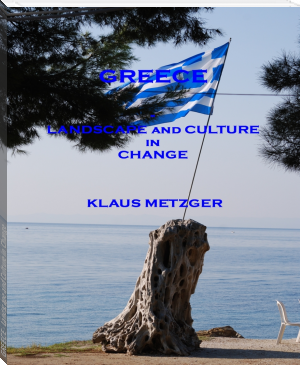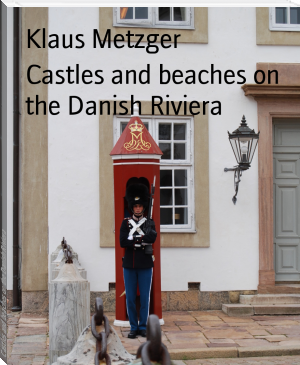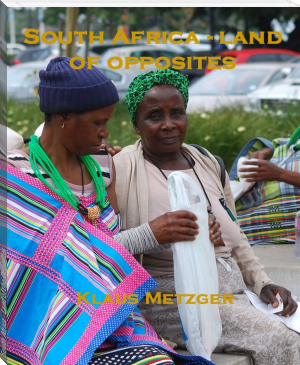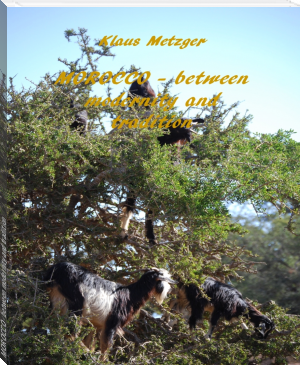GREECE - Landscape and Culture in Change by Klaus Metzger (thriller book recommendations TXT) 📕

- Author: Klaus Metzger
Book online «GREECE - Landscape and Culture in Change by Klaus Metzger (thriller book recommendations TXT) 📕». Author Klaus Metzger
We believe in Greek mythology, Zeus himself as the Libyan princess Europa on the island of Crete, and begat among other things, the future King Minos with her. Minos, who wanted to demonstrate his divine descent, requested of Poseidon, god of the sea, a bull. Poseidon granted his request with a request that this magnificent bull to be sacrificed in his honor.
Upon receipt of this bull but thought no more about King Minos to sacrifice the gift to the god Poseidon. In his anger Poseidon saw to it that the Queen Pasiphae felt, passion for the bull. From this union sprang the Minotaur. Half man, half bull, he was imprisoned by Minos in the labyrinth of Knossos Palace. Every 7 years human sacrifices were supplied to him from the mainland. Only Theseus was able to penetrate with the help of Ariadne and the famous thread into the interior of the labyrinth and killed the monster.
Hotel Creta Royal
Today Crete is the largest island of Greece (8333 km²) and the southernmost of Europe. It is considered the birthplace of the Minoan civilization 4,000 years ago and is the cradle of all European culture. Due to its strategic location in the western defense alliance is there a major missile and naval base. Our first trip takes us to Rethymnon (th - english spoken). Rethymnon, with 20,000 inhabitants, is the most oriental city on Crete with its numerous minarets and mosques. Most likely to succumb to the charm of the city in a journey through the streets of the old town to the picturesque harbor and its origin falls into the main heyday of the Venetian era.
A visit to the monastery of Arkadi leaves its mark on its visitors. In 1866 went hundreds of Cretans, including women and children, voluntarily into death, in order not to arrive during the siege by the Turks in the hands of the enemy. After a long swim program at the beach and at the pool, we embarked on a photo safari, the us - led down to the southern part CRETE - to the White Mountains and the Imbros Gorge over. First to Francocastello - followed by a visit to the Monastery of Preveli. The day ended with a beautiful sunset on the beach of Plakias - a beach, the preferred destination already in the 70s of the so-called "hippies" was. I myself was also at that time this awful nice platform shoes, flared pants, polo shirts with a rounded collar and a flower in her ear. For us it is always important to take breaks (eg at the pool) to exchange us about our impressions.
Coachman in Chania
While I firmly believe that the experiences in brief, I leave my husband fully responsible for the choice of motifs during our entire trip. So this time. Now you can shop with us through Chania (65,000 inhabitants). Around the Venetian harbor you will find historical and picturesque neighborhoods (Topanas quarter) and meet people in the maze and maze-like streets. They are about the variety of offerings of fruit, vegetables, fish, meat and spices in the market hall of Chania, which is located in the central square, amazed. But do not forget to enjoy an authentic Greek coffee in one of the many coffee shops that - contrary to all information - can also be attended by women.
Mosque in Chania
Slowly we come to the main part of our trip and finally and ultimately leads us to Heraklion (125,000 inhabitants). Since 1972, capital CRETE offers more hidden treasures among the attractions of the town center, which is located within the fortress walls from the Venetian period. It borders on the fishing port and the citadel Koules, where there is also the grave of Nicos Katzantzakis (author of "Zorba the Greek"). A visit to the archaeological museum with its fascinating collection of Minoan times is an absolute must. The Knossos Palace itself with its labyrinths, its excavation and reconstruction of the Englishman Sir Arthur Evans (born 1851 - died 1941.) Is due to roughly 8 km away. Guided tours are recommended and in good hotels bookable in advance.
Painting in the Knossos Palace
Knossos Palace
Knossos Palace
As a conclusion, a visit to the mountain village Anoghia in our program. I think it's always important to establish contact with the country and its people living there. I was surprised that even in a small village in the mountains, the time has not stood still. In addition to the usual police and ambulance stadium you will also get money from the ATM. You can also sense here that makes a proud Greeks: a sense of family, idealism, joy of playing and socializing, political discussions, awake curiosity and enjoyment of the moment. On Crete you find all these qualities, just .... everything is a little harder. Incidentally, the Anoghia was completely destroyed during the second world war by the German Wehrmacht.
To round out my article would be more to report that Cretan olive oil and honey are very popular souvenirs; also sheep wool sweaters. However, sheep and goat farming in time cause serious damage to the vegetation. If you think, but this is a nice, big bird there on the tree, you can assume it is a goat. But do not forget and also gold and silver jewelery precious lacework, mostly dressed in black older women of the village are sitting in the sun and grandchildren herding, customized. Did you know that to grow CRETE 35 million olive trees? I hope we were once again able to give you some suggestions for a relaxing and interesting holiday.
2006 - clues in Ancient Greece
Ferry in the harbor of Nea Styra (Evia)
Again JUTTA has written an impressive trip report that I have not been changed. The hotel and the island was a gigantic disappointment for us. Two years before the 2008 financial crisis and the near-bankruptcy could see very well that the Greeks had completely lost touch with a courteous behavior towards the tourists. We felt really ripped off - without reasonable consideration. But JUTTA formulated in great detail, but the more times quoted educational trip was a memorable win:
After Crete Evia is the next largest island with about 165,000 inhabitants. Tourist still not as developed, it naturally has in this area substantial shortcomings. Nevertheless, Evia offers good opportunities to start from here to the ancient sites of Greece and to come up with rest and relaxation in return. Evia still distinguished by their original Greek charm.
Our main travel theme this fall was the search for clues in ancient Greece. After 3½ hours flight from Frankfurt to Athens (a feeder flight took us from Hannover to Frankfurt) and the somewhat strenuous transfer: Athens - Agia Marina Port - Ferry Evia-Nea Styra is it to acclimate in our 4-star hotel. Two days you should take take time for relaxing time as our already in Germany booked excursions are also not without their season.
The first stage leads us once about the most interesting places on the island. These include churches, monasteries and medicinal springs. Often isolated, helps us a well informed and a German / English speaking tour guide to the destination. But well labeled trails allow us the clear design of the days we spend on the island. It is a rich flora and fauna gives us. We find pistachio trees, wine, bay leaf, thyme, chaste tree, rubber tree, olives, rosemary, eucalyptus, castor bean, mulberry and cotton fields. Our noses take on the beguiling variety of odors.
You can get enough of smell in the truest sense of the word. Goats and sheep, deliver their milk, the typical basis for the feta cheese, the island image shape as well as foxes and rabbits, but these are chased with the shotgun. On Evia some families living from fishing, the beach front hotel offers a restaurant connected with a good source of income for the entire family. Geological deposits are mainly copper and marble. The marble from Evia was used in the construction of the four pillars of St. Peter's Basilica. The visit of a Greek Orthodox church service allows deep insight into the religious community life. Women and men do - grouped separately - participated. Nothing is intended to pure meditation that has its place and its determination bother. Similarity can be found in other religions during the service.
After our first day exploring the island tour you will visit us Delphi. From our hotel in Nea Styra from, we first went to the west coast to the Island Capital Chalkida. Then we traverse a bridge over the narrowest point of the sea. To the north it goes along the national road that Athens connected with the North. There we see many iconostasis. These are small chapels, equipped with an icon, a bottle of oil and an oil lamp, to remind the roadside in a tragic car accident. In this case, the occupant came either to death or giving thanks on this way for survival.
Passing the modern Thebes we approach Boeotia, one of the most fertile regions of Greece. Today Thebes was built on the ruins of the ancient city (356-323 BC) and 335 BC Alexander, son of Philip II of Macedon (382-336 BC) destroyed the place. It was already inhabited 4000 years ago. Thebes was a great venue Greek tragedies. According to the historical tradition of the War of the seven generals from Argos against Thebes took place here. According to Greek mythology, Zeus here with the earthly mother Semele the god of wine - begotten Bacchus or Dionysus. Semele, however, was struck by lightning when her Zeus was seen in a suit of armor. Also Oedipus (King of Thebes) was in this plane home.
In Boeotia we find wide cotton fields, because Greece is to North America, Egypt and Turkey's fourth largest exporter of cotton. Greek tomatoes, beans, olives, peppers, peaches, peppers, melons, lemons and oranges are grown here and also made available on the international market. In a short rest we taste the Retsina - a wine that is used in the production of which pine resin. It is the house wine of the Greeks. either you like this wine immediately or only after the fourth or fifth glass.
Treasury of the Athenians
The olive branch is a sign of peace and harmony and was also presented at the Olympic Games to crown champions. Also, Delphi is like an island in an olive grove. Earlier this site was dedicated their patron Apollo - today it is a great excavation site. On the way we stop again for a short rest in the village of Arachova. A mountain village, such as carved seems to hang on a mountainside and therefore is listed there. Right before us the 2400m high mountain massif of Mount Parnassus. Formerly a sacred mountain - Apollo (god of light and the Muses consecrated) - is the Parnass today a very popular ski resort.
The Temple of Apollo
We are approaching Delphi. 2000 years ago here was Gaia, worshiped the Mother Earth. From a fissure occurred vapors to the surface, which advised the priestess Sybilla in a trance and let prophesy.





Comments (0)